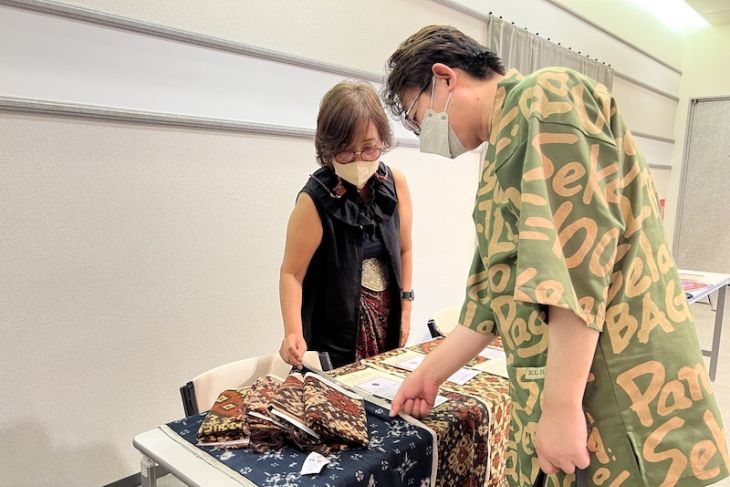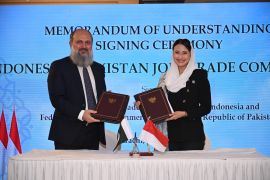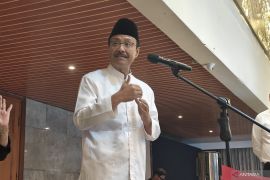Some were stacked, others were spread out, while some were sewn into suits, dresses, and other pieces of clothing.
Batik and Kimono worn by people behind the tables offered a hint to visitors that some pieces of fabric on one table were from Indonesia while those on the other one were from Japan.
However, who would have guessed that the fabrics were connected through imaginary “red threads” revealing that both were traditional woven fabrics: Tenun Gringsing from Bali and Kurume Gasuri from Fukuoka.
Even more surprisingly was the fact that both were made using a similar technique, that is double tie, or known as ikat. Such a technique is only found in three countries in the world: Indonesia, India, and Japan.
Karacitra Foundation Chairwoman Rere Wulandari, who works on Tenun Gringsing, said that the fabric originated from Tenganan Village, Penggringsingan, Karangasem Sub-district, East Bali.
“The similarity between Tenun Gringsing and Kurume Gasuri from Fukuoka is the technique known as double tie in which yarns are not only colored horizontally but also vertically,” she explained.
The entire process of woven-fabric making between Tenun Gringsing and Kurume Gasuri is quite similar. It starts with firstly making the design of motifs by tying the yarns both horizontally and vertically. The motifs will appear from the combination of the tied yarns.
The second process entails coloring the yarns. The fabrics of Tenun Gringsing are commonly dyed with natural coloring derived from roots of noni (Morinda citrifolia) to obtain yellow color.
The yarns that have been colored are then dried in the sun. After all have been dried, they are tied in the loom and are ready to be woven.

However, there lies a difference between the woven fabric from Bali and Fukuoka, Wulandari highlighted. Tenun Gringsing still goes through a manual process with a traditional loom, while machines are used for Kurume Gasuri.
“Then why manual? It is because the use of this Tenun Gringsing is varied. This is still used for religious ceremonies in the village where the residents hold such ceremonies throughout the year,” she pointed out.
Nowadays, the woven fabric has started to be produced outside Tenganan Pegringsingan Village, though it remains in Bali area, she said while adding that the fabric has already been used by Barong dancers.
Meanwhile, motifs on the fabric are still influenced by those of Indian-woven fabrics that had existed two centuries BC.
“For the ritual, they use fabrics with darker colors, such as black, red, and yellow. Moreover, there are some certain characteristics in the motifs while the fabrics with indigo dyeing are common for fashion,” Wulandari remarked.
Currently, Tenun Gringsing fabrics are increasingly in demand by collectors, either for personal collection or for fashion purposes, she added.
Madoka Koga, a representative from Coppolart’s Kurume Gasuri, said that the fabric originated from Fukuoka, Kyushu, Japan, 220 years ago.
“Now, there are two main methods to make the fabrics. One is all handmade and the other is by machine. The handmade one is still weaved by hand and using natural-made indigo dyeing,” she explained.
The motifs of Kurume Gasuri are basically inspired from nature, such as the view of sky, the color of the sea, and the flow of the river, and also includes the changing of the four seasons and the various scents.
“Now I am witnessing the double-tie woven fabrics from Indonesia and Japan’s Kurume Gasuri. I am looking forward to some collaboration,” Koga remarked.

Means of Diplomacy
The link between traditional woven fabrics from Indonesia and Japan is expected to strengthen relations between both countries that had established diplomatic ties for 65 years.
Indonesian Ambassador to Japan and Federated States of Micronesia Heri Akhmadi stressed that relations between Indonesia and Japan transcend political and economic issues while adding that they are also connected in terms of the cultural, humanity, and environmental aspects.
Japan is well-known for its fabric-making techniques that count over one thousand techniques. The double tie is among the techniques similar to the Indonesian traditional woven fabric from Bali.
Hence, the uniqueness is expected to bridge the gap in people-to-people relations between Indonesia and Japan to learn experiences from one another since strong relations between two countries were built from the connection among their people, according to the ambassador.
“Hence, the best relation of a big family is a direct relation among the people,” Akhmadi underlined.

“On the occasion, I am specially informed that there is a workshop on Balinese Tenun Gringsing and Fukuoka’s Kurume Gasuri that are both popular due to their double-tie technique. I hope the participants would participate in cultural exchanges between the two countries,” he remarked.
He expressed hope that the people of Japan and Indonesia would gain a deeper understanding of Indonesia's culture and find similarities and differences between both countries.
It is a huge opportunity to bring back each cultural enchantment found and tell close relatives about it to gain more traction among people towards Indonesia and Japan that is better than before, according to Kanasugi.
He acknowledged feeling surprised on knowing about Indonesia's diversity for one and half years since first being deployed and serving as Japan’s ambassador in Indonesia.
"The more I know about it, the deeper and more interesting it becomes for me," Kanasugi affirmed.
Related news: Wastraprema displays 138 rare woven fabrics at Jakarta Textile Museum
Related news: Proud to join G20 Sherpa exhibition: MSME actors
Related news: Environment-friendly woven "balase" craft should be nurtured
Editor: Sri Haryati
Copyright © ANTARA 2022












